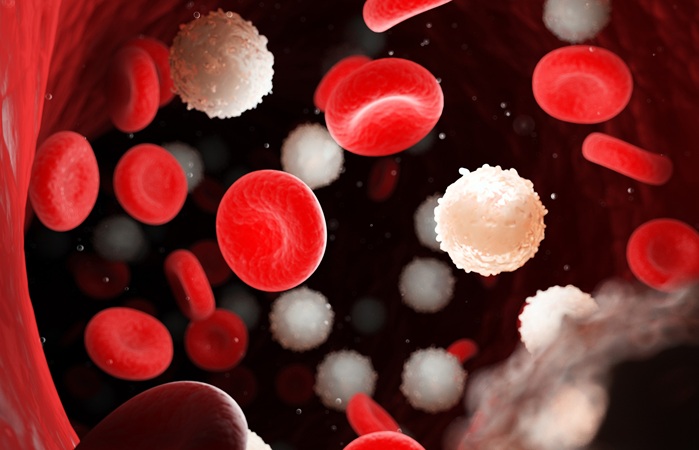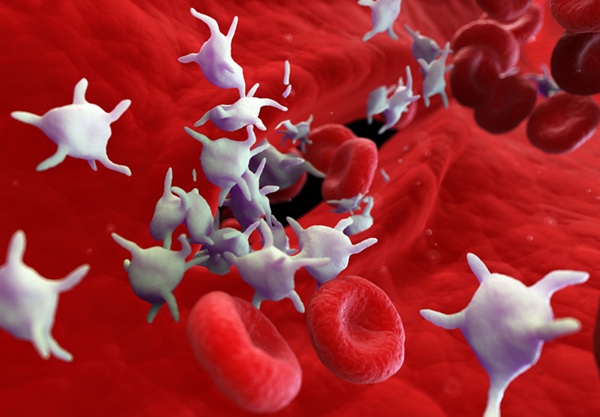Inhibiting Fibronectin Polymerization Reduces Injury to Cardiac Muscle
|
By LabMedica International staff writers Posted on 24 Apr 2018 |
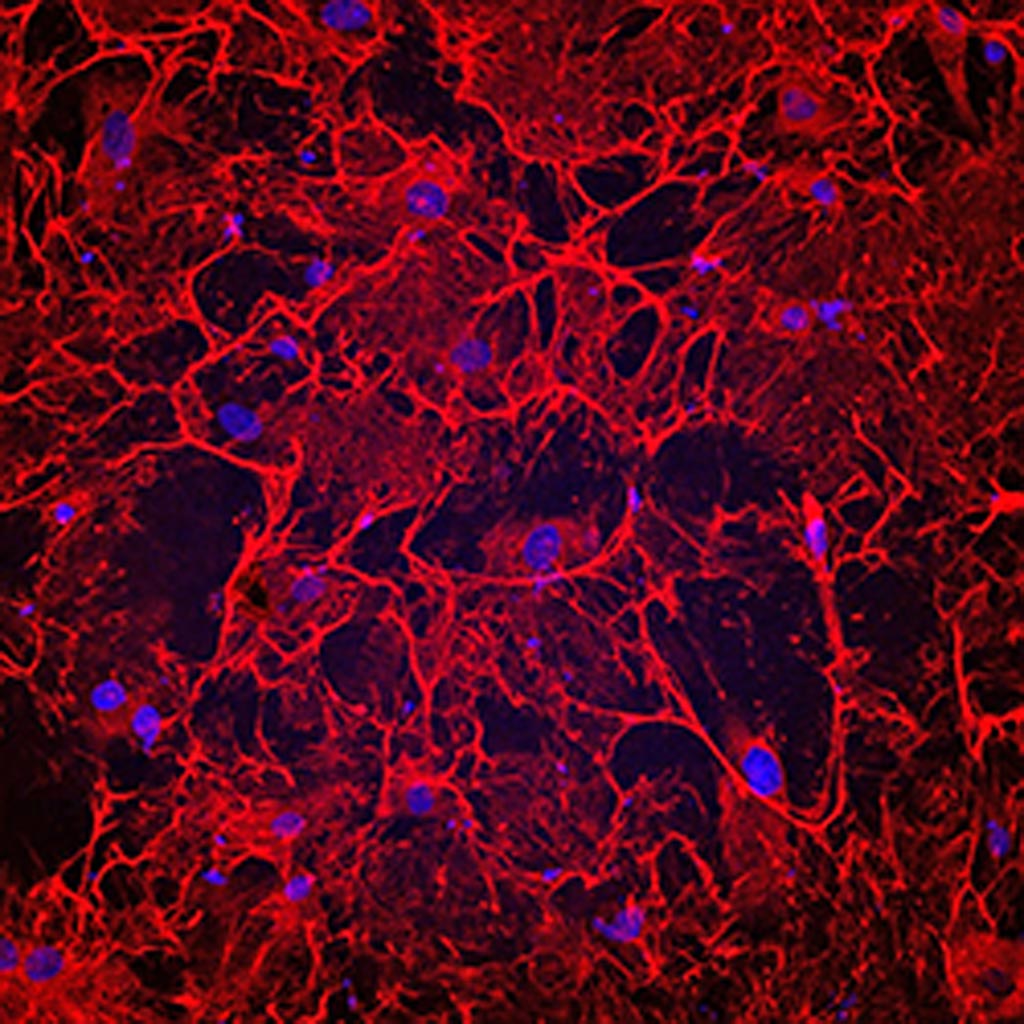
Image: A photomicrograph showing fibrotic heart cells from a patient who had heart failure. The cells have an elaborate fibronectin matrix (shown in red), which causes fibrosis and heart damage (Photo courtesy of Cincinnati Children\'s Hospital Medical Center).
Working with a mouse model of human heart disease, researchers showed that interfering with fibronectin (FN) polymerization or its genetic deletion in fibroblasts would attenuate cardiac myofibroblasts (MF), fibrosis, and improve cardiac function following heart attack related injury.
Fibronectin is a high-molecular weight glycoprotein of the extracellular matrix that binds to integrin receptor proteins. Similar to integrins, fibronectin binds extracellular matrix components such as collagen, fibrin, and heparan sulfate proteoglycans. Fibronectin exists as a protein dimer, consisting of two nearly identical monomers linked by a pair of disulfide bonds. The fibronectin protein is produced from a single gene, but alternative splicing of its pre-mRNA leads to the creation of several isoforms. Fibronectin plays a major role in cell adhesion, growth, migration, and differentiation, and it is important for processes such as wound healing and embryonic development. Altered fibronectin expression, degradation, and organization have been associated with a number of pathologies, including cancer and fibrosis.
Fibronectin (FN) polymerization is necessary for collagen matrix deposition and is a key contributor to increased abundance of cardiac myofibroblasts (MF) following cardiac injury. To better understand the role of FN polymerization, investigators at Cincinnati Children's Hospital Medical Center (OH, USA) used the synthetic polymerization inhibitor peptide pUR4 to assess the impact of blocking FN polymerization on pathologic cellular features such as proliferation, migration, extracellular matrix (ECM) deposition, and associated mechanisms.
To evaluate the therapeutic potential of inhibiting FN polymerization in vivo, wildtype (WT) mice received daily intraperitoneal injections of either pUR4 or a control peptide (III-11C) immediately after cardiac surgery, for seven consecutive days. Mice were analyzed seven days post-injury to assess myofibroblast markers and inflammatory cell infiltration, or four weeks post-injury, to evaluate long-term effects of FN inhibition on cardiac function and fibrosis. Further, inducible, fibroblast-restricted, FN gene ablated mice were utilized to evaluate cell specificity of FN expression and polymerization in the heart.
Results published in the April 13, 2018, online edition of the journal Circulation revealed that pUR4 administration on activated MF reduced FN and collagen deposition into the ECM and attenuated cell proliferation, likely mediated through decreased c-myc signaling. The pUR4 peptide also enhanced fibroblast migration accompanied by increased beta-1 integrin internalization and reduced levels of phosphorylated focal adhesion kinase (FAK) protein. Daily administration of pUR4 in vivo for seven days following injury significantly reduced MF markers and neutrophil infiltration. This treatment regimen also significantly lessened myocardial dysfunction, pathologic cardiac remodeling, and fibrosis up to four weeks post-injury. Finally, inducible ablation of FN in fibroblasts post-injury resulted in significant functional cardio-protection with reduced hypertrophy and fibrosis.
"Our data are a strong proof of principle and the first to show that inhibiting fibronectin polymerization preserves heart function, reduces left ventricle remodeling and limits formation of fibrotic connective tissue," said senior author Dr. Burns Blaxall, director of translational research in the heart institute at Cincinnati Children's Hospital Medical Center.
Related Links:
Cincinnati Children's Hospital Medical Center
Fibronectin is a high-molecular weight glycoprotein of the extracellular matrix that binds to integrin receptor proteins. Similar to integrins, fibronectin binds extracellular matrix components such as collagen, fibrin, and heparan sulfate proteoglycans. Fibronectin exists as a protein dimer, consisting of two nearly identical monomers linked by a pair of disulfide bonds. The fibronectin protein is produced from a single gene, but alternative splicing of its pre-mRNA leads to the creation of several isoforms. Fibronectin plays a major role in cell adhesion, growth, migration, and differentiation, and it is important for processes such as wound healing and embryonic development. Altered fibronectin expression, degradation, and organization have been associated with a number of pathologies, including cancer and fibrosis.
Fibronectin (FN) polymerization is necessary for collagen matrix deposition and is a key contributor to increased abundance of cardiac myofibroblasts (MF) following cardiac injury. To better understand the role of FN polymerization, investigators at Cincinnati Children's Hospital Medical Center (OH, USA) used the synthetic polymerization inhibitor peptide pUR4 to assess the impact of blocking FN polymerization on pathologic cellular features such as proliferation, migration, extracellular matrix (ECM) deposition, and associated mechanisms.
To evaluate the therapeutic potential of inhibiting FN polymerization in vivo, wildtype (WT) mice received daily intraperitoneal injections of either pUR4 or a control peptide (III-11C) immediately after cardiac surgery, for seven consecutive days. Mice were analyzed seven days post-injury to assess myofibroblast markers and inflammatory cell infiltration, or four weeks post-injury, to evaluate long-term effects of FN inhibition on cardiac function and fibrosis. Further, inducible, fibroblast-restricted, FN gene ablated mice were utilized to evaluate cell specificity of FN expression and polymerization in the heart.
Results published in the April 13, 2018, online edition of the journal Circulation revealed that pUR4 administration on activated MF reduced FN and collagen deposition into the ECM and attenuated cell proliferation, likely mediated through decreased c-myc signaling. The pUR4 peptide also enhanced fibroblast migration accompanied by increased beta-1 integrin internalization and reduced levels of phosphorylated focal adhesion kinase (FAK) protein. Daily administration of pUR4 in vivo for seven days following injury significantly reduced MF markers and neutrophil infiltration. This treatment regimen also significantly lessened myocardial dysfunction, pathologic cardiac remodeling, and fibrosis up to four weeks post-injury. Finally, inducible ablation of FN in fibroblasts post-injury resulted in significant functional cardio-protection with reduced hypertrophy and fibrosis.
"Our data are a strong proof of principle and the first to show that inhibiting fibronectin polymerization preserves heart function, reduces left ventricle remodeling and limits formation of fibrotic connective tissue," said senior author Dr. Burns Blaxall, director of translational research in the heart institute at Cincinnati Children's Hospital Medical Center.
Related Links:
Cincinnati Children's Hospital Medical Center
Latest BioResearch News
- Genome Analysis Predicts Likelihood of Neurodisability in Oxygen-Deprived Newborns
- Gene Panel Predicts Disease Progession for Patients with B-cell Lymphoma
- New Method Simplifies Preparation of Tumor Genomic DNA Libraries
- New Tool Developed for Diagnosis of Chronic HBV Infection
- Panel of Genetic Loci Accurately Predicts Risk of Developing Gout
- Disrupted TGFB Signaling Linked to Increased Cancer-Related Bacteria
- Gene Fusion Protein Proposed as Prostate Cancer Biomarker
- NIV Test to Diagnose and Monitor Vascular Complications in Diabetes
- Semen Exosome MicroRNA Proves Biomarker for Prostate Cancer
- Genetic Loci Link Plasma Lipid Levels to CVD Risk
- Newly Identified Gene Network Aids in Early Diagnosis of Autism Spectrum Disorder
- Link Confirmed between Living in Poverty and Developing Diseases
- Genomic Study Identifies Kidney Disease Loci in Type I Diabetes Patients
- Liquid Biopsy More Effective for Analyzing Tumor Drug Resistance Mutations
- New Liquid Biopsy Assay Reveals Host-Pathogen Interactions
- Method Developed for Enriching Trophoblast Population in Samples
Channels
Clinical Chemistry
view channel
‘Brilliantly Luminous’ Nanoscale Chemical Tool to Improve Disease Detection
Thousands of commercially available glowing molecules known as fluorophores are commonly used in medical imaging, disease detection, biomarker tagging, and chemical analysis. They are also integral in... Read more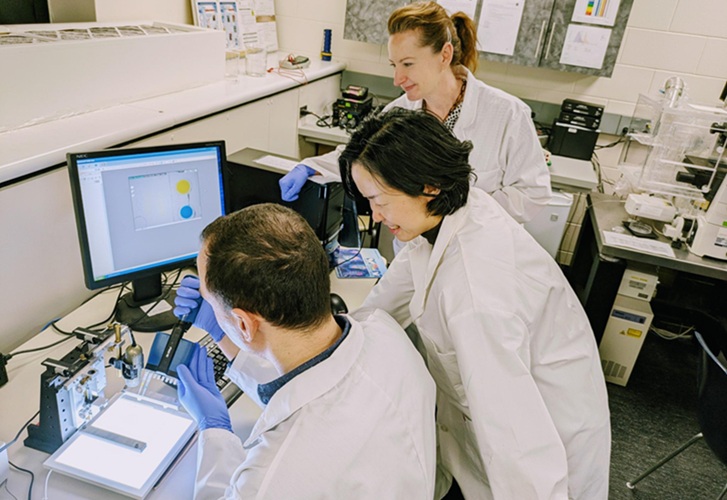
Low-Cost Portable Screening Test to Transform Kidney Disease Detection
Millions of individuals suffer from kidney disease, which often remains undiagnosed until it has reached a critical stage. This silent epidemic not only diminishes the quality of life for those affected... Read more
New Method Uses Pulsed Infrared Light to Find Cancer's 'Fingerprints' In Blood Plasma
Cancer diagnoses have traditionally relied on invasive or time-consuming procedures like tissue biopsies. Now, new research published in ACS Central Science introduces a method that utilizes pulsed infrared... Read moreMolecular Diagnostics
view channel
Simple Blood Test Improves Heart Attack and Stroke Risk Prediction
Troponin is a protein found in heart muscle cells that is released into the bloodstream when the heart is damaged. High-sensitivity troponin blood tests are commonly used in hospitals to diagnose heart... Read more
Blood Biomarker Test Could Detect Genetic Predisposition to Alzheimer’s
New medications for Alzheimer’s disease, the most common form of dementia, are now becoming available. These treatments, known as “amyloid antibodies,” work by promoting the removal of small deposits from... Read more
Novel Autoantibody Against DAGLA Discovered in Cerebellitis
Autoimmune cerebellar ataxias are strongly disabling disorders characterized by an impaired ability to coordinate muscle movement. Cerebellar autoantibodies serve as useful biomarkers to support rapid... Read more
Gene-Based Blood Test Accurately Predicts Tumor Recurrence of Advanced Skin Cancer
Melanoma, an aggressive form of skin cancer, becomes extremely difficult to treat once it spreads to other parts of the body. For patients with metastatic melanoma tumors that cannot be surgically removed... Read moreHematology
view channel
New Scoring System Predicts Risk of Developing Cancer from Common Blood Disorder
Clonal cytopenia of undetermined significance (CCUS) is a blood disorder commonly found in older adults, characterized by mutations in blood cells and a low blood count, but without any obvious cause or... Read more
Non-Invasive Prenatal Test for Fetal RhD Status Demonstrates 100% Accuracy
In the United States, approximately 15% of pregnant individuals are RhD-negative. However, in about 40% of these cases, the fetus is also RhD-negative, making the administration of RhoGAM unnecessary.... Read moreImmunology
view channel
Stem Cell Test Predicts Treatment Outcome for Patients with Platinum-Resistant Ovarian Cancer
Epithelial ovarian cancer frequently responds to chemotherapy initially, but eventually, the tumor develops resistance to the therapy, leading to regrowth. This resistance is partially due to the activation... Read more
Machine Learning-Enabled Blood Test Predicts Immunotherapy Response in Lymphoma Patients
Chimeric antigen receptor (CAR) T-cell therapy has emerged as one of the most promising recent developments in the treatment of blood cancers. However, over half of non-Hodgkin lymphoma (NHL) patients... Read moreMicrobiology
view channel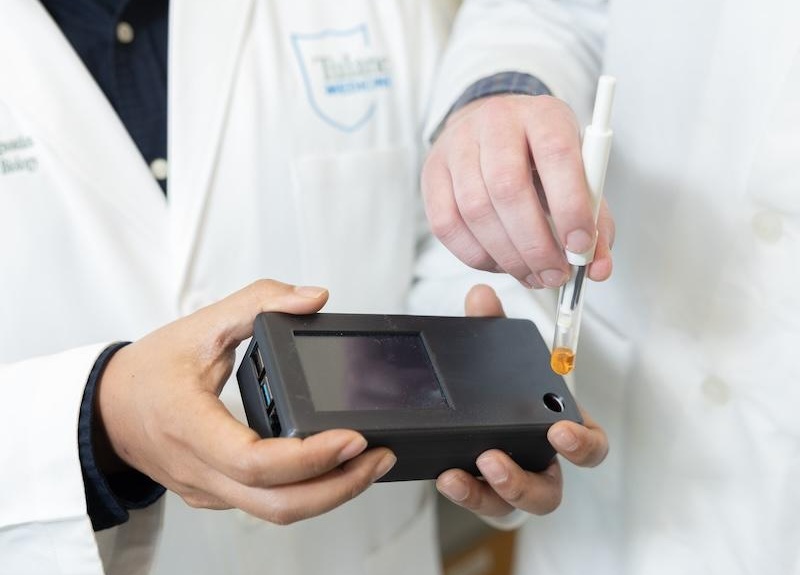
Handheld Device Delivers Low-Cost TB Results in Less Than One Hour
Tuberculosis (TB) remains the deadliest infectious disease globally, affecting an estimated 10 million people annually. In 2021, about 4.2 million TB cases went undiagnosed or unreported, mainly due to... Read more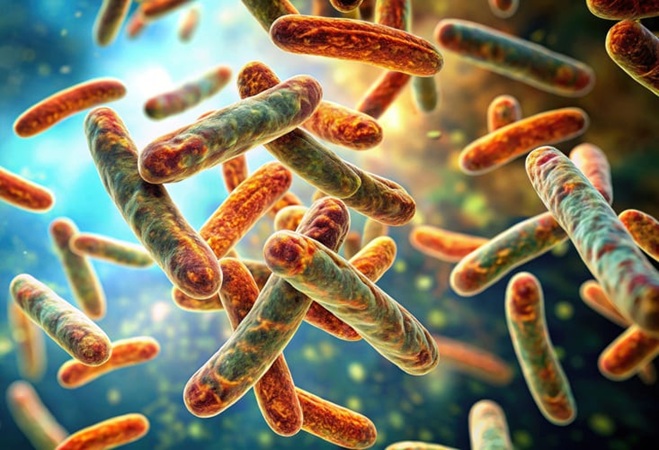
New AI-Based Method Improves Diagnosis of Drug-Resistant Infections
Drug-resistant infections, particularly those caused by deadly bacteria like tuberculosis and staphylococcus, are rapidly emerging as a global health emergency. These infections are more difficult to treat,... Read more
Breakthrough Diagnostic Technology Identifies Bacterial Infections with Almost 100% Accuracy within Three Hours
Rapid and precise identification of pathogenic microbes in patient samples is essential for the effective treatment of acute infectious diseases, such as sepsis. The fluorescence in situ hybridization... Read morePathology
view channel
Spit Test More Accurate at Identifying Future Prostate Cancer Risk
Currently, blood tests that measure the level of a protein called prostate-specific antigen (PSA) are commonly used to identify men at higher risk for prostate cancer. This test is typically used based... Read moreDNA Nanotechnology Boosts Sensitivity of Test Strips
Since the Covid-19 pandemic, most people have become familiar with paper-based rapid test strips, also known as lateral flow immunoassays (LFIAs). These tests are used to quickly detect biomarkers that... Read more
Novel UV and Machine Learning-Aided Method Detects Microbial Contamination in Cell Cultures
Cell therapy holds great potential in treating diseases such as cancers, inflammatory conditions, and chronic degenerative disorders by manipulating or replacing cells to restore function or combat disease.... Read moreTechnology
view channel
Disposable Microchip Technology Could Selectively Detect HIV in Whole Blood Samples
As of the end of 2023, approximately 40 million people globally were living with HIV, and around 630,000 individuals died from AIDS-related illnesses that same year. Despite a substantial decline in deaths... Read more
Pain-On-A-Chip Microfluidic Device Determines Types of Chronic Pain from Blood Samples
Chronic pain is a widespread condition that remains difficult to manage, and existing clinical methods for its treatment rely largely on self-reporting, which can be subjective and especially problematic... Read more
Innovative, Label-Free Ratiometric Fluorosensor Enables More Sensitive Viral RNA Detection
Viruses present a major global health risk, as demonstrated by recent pandemics, making early detection and identification essential for preventing new outbreaks. While traditional detection methods are... Read moreIndustry
view channel
Cepheid and Oxford Nanopore Technologies Partner on Advancing Automated Sequencing-Based Solutions
Cepheid (Sunnyvale, CA, USA), a leading molecular diagnostics company, and Oxford Nanopore Technologies (Oxford, UK), the company behind a new generation of sequencing-based molecular analysis technologies,... Read more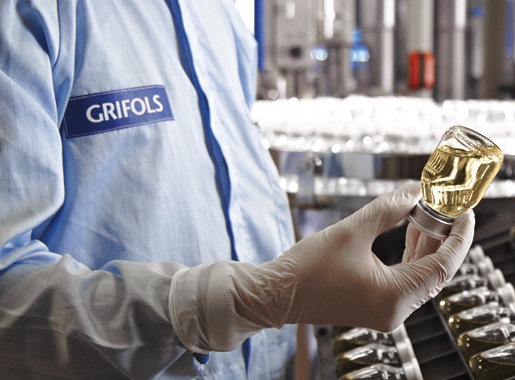
Grifols and Tecan’s IBL Collaborate on Advanced Biomarker Panels
Grifols (Barcelona, Spain), one of the world’s leading producers of plasma-derived medicines and innovative diagnostic solutions, is expanding its offer in clinical diagnostics through a strategic partnership... Read more












